
Thomas Mukambilwa
Managing Director of African Support and Project Centre Mukambilwa advocates for the improvement of Congolese lives in London through educational and health events

JJ Bola
Writer, Poet, Educator, Human. Author of No Place to Call Home. Spoken word poet turned author, Bola has read and spoken internationally at TedTalks and festivals.

Vava Tampa
Founder of Save the Congo; Activist and Rhumba lover. Tampa has been advocating for peace and justice in the Democratic Republic of Congo since 2008.
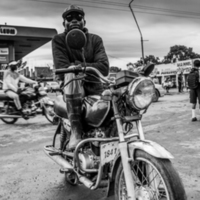
Danze: A Film by Yole!Africa
About the Collection
This collection documents the work of a community-based partnership between the Antislavery Usable Past project and Yole!Africa in Goma and Lubumbashi. The project is based on an archive of photography produced by the British missionary Alice Seeley Harris during her time in the Congo Free State in the late nineteenth and early twentieth century. The project has used the visual archive as a basis for working with young people to explore the history and legacies of colonialism during the time at which the Congo Free State was under the personal ownership of King Leopold II of Belgium.
Defining what the ‘antislavery usable past’ of these images is raises questions of power and representation. Who gets to decide? The writing of history is a powerful tool – who is included and excluded from the story, indeed, who gets to write it in the first place, is a reflection of the inequalities of the society within which that history is produced. Working with a colonial archive in Britain - a former centre of empire - raises issues about who gets to access history. For formerly colonised people their histories, or at least the portion of their histories relating to the colonial experience, are often found in the archives, museums, and art galleries of the former colonising power. Alice’s photographs, for example, eventually became part of the archive of the British and Foreign Antislavery Society, which subsequently became the present-day NGO Antislavery International. The archive is held at the Bodleian Library, University of Oxford. For people resident within the former spaces of empire, the physical impracticality of visiting the collection means a separation from the objects, documents, and images which represent their past.
This project offers a new way of working with colonial archives and in particular with the living communities whose past is present within these images of imperial exploitation. Working with these images within the communities that they represent is an important part of ceding control of the past. The aim is to make history useful and usable by telling the stories that matter to them. Returning photographs from Alice’s archive to the country in which it was produced allows Congolese people to decide for themselves what the usable past of the images might be. Developments in digitisation mean that an archive can be liberated from its physical location. With generous permission from Antislavery International, the Bodleian Library digitised the entire surviving collection of 509 photographs. Transformed from a rather unwieldy set of boxes into a hard drive, the collection gained the mobility necessary to work with partners in the Congo.
Through the critical and creative programme of education developed by Yole!Africa, Alice’s images have circulated among young people in Goma and Lubumbashi, who actively engage them when discussing their ideas about history, identity, and memory. Their powerful and insightful analysis of the images has given the photographs new meanings, which make them relevant for the present—not only in Congo, but also in former colonizing nations. Moreover, their artistic responses to the past demand that we reflect on the priorities motivating young people in formerly colonized countries and their critiques of contemporary society. Self-representation is central to the idea of freedom. Yole!Africa’s Executive Director Chérie Rivers Ndaliko has written about the power of self-representation stating that ‘When one’s story is one’s only possession of value, telling it becomes a matter of life and death… storytelling, more than taking arms, restores agency to those who have historically been the subject, indeed the collateral damage in this battle.’ With this in mind, we have actively sought the stories and opinions of those historically subjected to colonial domination, inviting them to amend historical records with their responses to colonial representations.
This collection contains a series of photographs which have been produced by young people in Goma and Lubumbashi in response to the original archive of Alice Seeley Harris images. They have been invited to recreate, contradict and recompose the images in relation to their own priorities. They explore themes of class, gender, race, sexuality, memory, labour, culture and history. These images formed part of an exhibition which took place at the Congo International Film Festival which was held at Yole!Africa in Goma in July 2018.
You can also view a film which has been created by Petna Katondolo Ndaliko which reflects on the relationship between history, memory and identity in relation to some of the issues raised by the Alice Seeley Harris archive and the histories it represents.
To access the original collection of photographs that this project engaged with you can search via the ‘Alternative Tag’ or you can click through the to ‘Alice Seeley Harris Archive’ and the ‘Congo Atrocity Lantern Lecture’.
A partner project was commissioned which explores similar issues in relation to the Congolese diaspora in London. You can access this material by clicking through to the collection ‘You Should Know Me: Photography and the Congolese Diaspora’.
The project has also collaborated closely with the Antislavery Knowledge Network, which is based at the University of Liverpool, and seeks community-led strategies for creative and heritage-based interventions in sub-Saharan Africa.
Copyright and takedown policy
Copyrights to all resources are retained by the Antislavery Usable Past project and Yole!Africa. The images and resources are available for educational and non-commercial use only. All efforts have been made to obtain copyright permission for materials featured on this site. If you are aware of instances where the rights holder(s) has not been given an appropriate credit, please let us know. If you hold the rights to any item(s) included in this resource and oppose to its use, please contact us to request its removal from the website.
Contact
Email: [email protected]
Acknowledgements
This project would not have been possible without the tireless work, energy, and commitment (both financial and intellectual) of Yole!Africa and its Artistic Director Petna Katondolo Ndaliko and Executive Director Dr. Chérie Rivers Ndaliko. Their support and enthusiasm has seen this project through its various phases and better partners could not have been asked for. Student ambassador Bernadette Vivuya has helped as both a participant and an organiser and has been a vital part of the project. We would like to thank Carlee Forbes (University of North Carolina) for her expertise on Congolese pre-colonial art and her help with the workshop in Goma. Our thanks also to Sammy Baloji and the team at PICHA! Gallery in Lubumbashi. Thanks to Dr Robert Burroughs (Leeds Beckett University) for offering important perspectives on Congolese resistance. Further thanks go to the Antislavery Knowledge Network, based at the University of Liverpool.
Further reading
Robert Burroughs, African testimony in the movement for Congo reform: The burden of proof (Abingdon: Routledge, 2018)
Marie Godin and Giorgia Doná, ‘“Refugee voices,” new social media and politics of representation: Young Congolese in the diaspora and beyond, Refuge, 32:1 (2016), pp. 60-71
Aubrey Graham, ‘One hundred years of suffering? “Humanitarian crisis photography” and self-representation in the Democratic Republic of the Congo’, Social Dynamics, 40:1 (2014), pp. 140-63
Osumaka Likaka, Naming colonialism: History and collective memory in the Congo, 1870-1960 (Wisconsin: University of Wisconsin Press, 2009)
Jane Lydon, ‘“Behold the tears”: Photography as colonial witness’, History of Photography, 34:3 (2010), pp. 234-50
Patrick Mudekereza and Allen F. Roberts, ‘Picha: The second Biennale of photography and video art Lubumbashi, Democratic Republic of the Congo October 2010’, African Arts, 44:3 (2011), pp. 68-75
Chérie Rivers Ndaliko, Necessary noise: Music, film, and charitable imperialism in the East of Congo (Oxford: Oxford University Press, 2016)
Mark Sealy, ‘Decolonising the camera: Photography in racial time’ (Unpublished PhD thesis, University of Durham, 2016)
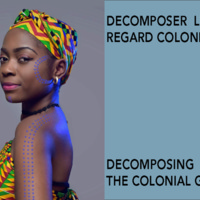
Decolonising the Colonial Gaze
Decolonising the Colonial Gaze
This collection documents the work of a community-based partnership between the Antislavery Usable Past project and Yole!Africa in Goma and Lubumbashi. The project is based on an archive of photography produced by the British missionary Alice Seeley Harris during her time in the Congo Free State in the late nineteenth and early twentieth century. The project has used the visual archive as a basis for working with young people to explore the history and legacies of colonialism during the time at which the Congo Free State was under the personal ownership of King Leopold II of Belgium.
Defining what the ‘antislavery usable past’ of these images is raises questions of power and representation. Who gets to decide? The writing of history is a powerful tool – who is included and excluded from the story, indeed, who gets to write it in the first place, is a reflection of the inequalities of the society within which that history is produced. Working with a colonial archive in Britain - a former centre of empire - raises issues about who gets to access history. For formerly colonised people their histories, or at least the portion of their histories relating to the colonial experience, are often found in the archives, museums, and art galleries of the former colonising power. Alice’s photographs, for example, eventually became part of the archive of the British and Foreign Antislavery Society, which subsequently became the present-day NGO Antislavery International. The archive is held at the Bodleian Library, University of Oxford. For people resident within the former spaces of empire, the physical impracticality of visiting the collection means a separation from the objects, documents, and images which represent their past.
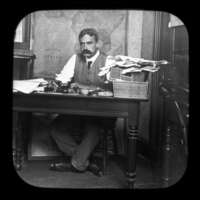
Edmund Dene Morel
A portrait of British abolitionist Edmund Dene Morel (1873-1924). Morel was a shippping clerk for the Liverpool company Elder Dempster which had a shipping contract between Antwerp and Boma. He raised the alarm about exploitative practices when he noticed that ships destined for the Congo Free State were packed with guns, chains and explosives rather than the usual trade good. In response to what he discovered Morel went on to found the Congo Reform Association. He also set up his own newspaper - The West African Mail - which focused on the commercial abuses being committed in the Congo Free State. This image (Neg. 7) formed part of the Harris Lantern Slide Collection. Under King Leopold II the Congo Free State used mass forced labour to extract rubber from the jungle for the European market. As consumer demand grew King Leopold II's private army - the Force Publique - used violent means to coerce the population into meeting quotas, including murder, mutilation, rape, village burning, starvation and hostage taking. Alice Seeley Harris and her husband Reverend John H. Harris were missionaries in the Congo Free State from the late 1890s. Alice produced a collection of images documenting the horrific abuses of the African rubber labourers. Her photographs are considered to be an important development in the history of humanitarian campaigning. The images were used in a number of publications. The Harrises also used the photographs to develop the Congo Atrocity Lantern Lecture which toured Britain and the the USA raising awareness of the issue of colonial abuses under King Leopold II's regime. Source: Antislavery International and Panos Pictures
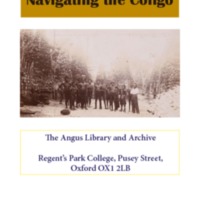
Navigating the Congo
Featuring artefacts, navigational equipment, maps, photographs, personal letters and diaries, Navigating the Congo is an exhibition which explored the history of non-conformist involvement in the Congo River regions during the 19th and 20th century.
By looking at the collections held in The Angus Library and Archive, the exhibition sought to bring to light some of the challenges faced in navigating this history and the relationships that developed between Baptist missionaries and the Kongo people during the period of European colonialism.
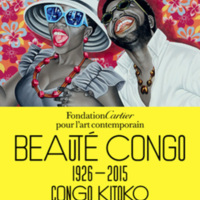
Beauté Congo – 1926-2015 – Congo Kitoko, Fondation Cartier, Paris (11 July 2015 - 10 January 2016)
A place of extraordinary cultural vitality, the creative spirit of the Democratic Republic of the Congo will be honored in the exhibition Beauté Congo – 1926-2015 – Congo Kitoko presented at the Fondation Cartier pour l’art contemporain with André Magnin, Chief Curator.
Modern painting in the Congo in the 1920s: Taking as its point of departure the birth of modern painting in the Congo in the 1920s, this ambitious exhibition will trace almost a century of the country’s artistic production. While specifically focusing on painting, it will also include music, sculpture, photography, and comics, providing the public with the unique opportunity to discover the diverse and vibrant art scene of the region.
Precursors: As early as the mid-1920s, when the Congo was still a Belgian colony, precursors such as Albert and Antoinette Lubaki and Djilatendo painted the first known Congolese works on paper, anticipating the development of modern and contemporary art. Figurative or geometric in style, their works represent village life, the natural world, dreams and legends with great poetry and imagination. Following World War II, the French painter Pierre Romain-Desfossés moved to the Congo and founded an art workshop called the Atelier du Hangar. In this workshop, active until the death of Desfossés in 1954, painters such as Bela Sara, Mwenze Kibwanga and Pili Pili Mulongoy learned to freely exercize their imaginations, creating colorful and enchanting works in their own highly inventive and distinctive styles.
Popular painters: Twenty years later, the exhibition Art Partout, presented in Kinshasa in 1978, revealed to the public the painters Chéri Samba, Chéri Chérin, and Moke and other artists, many of whom are still active today. Fascinated by their urban environment and collective memory, they would call themselves “popular painters.” They developed a new approach to figurative painting, inspired by daily, political or social events that were easily recognizable by their fellow citizens. Papa Mfumu’eto, known for his independent prolific comic book production and distribution throughout Kinshasa in the 1990s, also explored daily life and common struggles throughout his work. Today younger artists like J.-P. Mika and Monsengo Shula, tuned-in to current events on a global scale, carry on the approach of their elders.
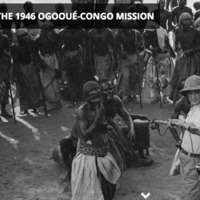
In the Footsteps of the 1946 Ogooué-Congo Mission, Online Exhibition, Europeana Collections
In 1947, 70 years ago, the public discovered one of the first sound recordings of Pygmy music collected in Equatorial Africa by the French ethnomusicologist Gilbert Rouget.
These were recorded during the Ogooué-Congo Mission, a scientific expedition led by the 23-year old French ethnologist Noël Ballif. This mission was the first organised by the Liotard group, a collective of young French explorers from Paris’ Musée de l’Homme.
From July to December 1946, the 12 members of the expedition travelled across the former Middle Congo (the current Republic of the Congo) and Gabon. They spent six weeks completely immersed in Bambinga Pygmy tribes from the Haute Sangha region, in the North of Moyen Congo - an experience that turned out to be decisive for some of them.
Whether they are sound recordings, photographs, films, artifacts or scientific studies, the documents collected and produced during and after the Ogooué-Congo Mission allow us to discover their adventure.
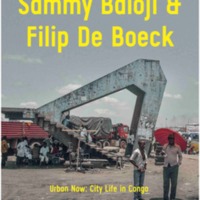
Urban Now: City Life in Congo, Various Venues (2016-2017)
This exhibition by photographer Sammy Baloji and anthropologist Filip De Boeck offers an exploration of different urban sites in Congo, through the media of photography and video. Focusing upon the “urban now”, a moment suspended between the broken dreams of a colonial past and the promises of neoliberal futures, the exhibition offers an artistic and ethnographic investigation of what living – and living together – might mean in Congo’s urban worlds.
As elsewhere on the African continent, Congo’s cities increasingly imagine new futures for themselves. Today, these new urban dreams often only manifest themselves in the form of billboards and advertisements for the city to come, inspired by Dubai and other recent hot spots from the Global South. Ironically, the city model they propose invariably gives rise to new geographies of exclusion that often take the form of gated communities and luxury satellite towns designed for a still somewhat hypothetical local upper middle class.
In sharp contrast with these neoliberal imaginings, the current infrastructure of Congo’s cities is of a rather different kind. The built colonial legacy has largely fallen into disrepair. Its functioning is punctuated by constant breakdown, and the city is replete with disconnected fragments, reminders and echoes of a former modernity that continues to exist in a shattered form. These failing material infrastructures greatly impact upon the quality of the city’s social life, and push it to the limit of what is livable. Yet Congo’s urban residents constantly engage in inventing new social spaces to bypass or overcome breakdown, exclusion, poverty and violence. Exploring these spaces, the exhibition captures a more inhabitable and inclusive urban world, where the possibilities of collective action and dreams of a shared future continue to be explored.
Curator: Devrim Bayar
The exhibition is organized in collaboration with and will travel to Galerias Municipais/EGEAC, Lisbon, and The Power Plant, Toronto.
With the support of the Research Fund of KU Leuven and Imane Farès Gallery, Paris.
In collaboration with Kunstenfestivaldesarts & Summer of Photography 2016.
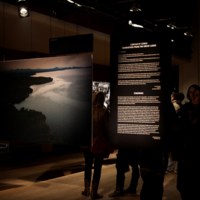
I Dream of Congo, Touring Exhibition, Congo Connect
‘I Dream of Congo: Narratives from The Great Lakes’ is a unique exhibition combining words and images from renowned international creatives alongside a groundbreaking exhibition of photos taken by women in eastern Congo. The exhibition celebrates the hope and optimism that pervades in the region despite years of war. It poses hard questions around the international community’s inaction in the face of the conflict, the continuing illicit trade in minerals from Congo and the failure to stem the tide of sexual violence.
During the February 2013 exhibition launch, The Frontline Club, Women for Women International, One Billion Rising and Save the Congo held events in the space that related to the theme. The exhibition was first shown in February 2013 at Conway Hall London, before moving on to other venues in the UK, including a conference on the Democratic Republic of Congo at St Andrews University in April 2013. In 2014, 'I Dream of Congo' formed part of the 'Brutal Exposure' exhibition at the International Slavery Museum in Liverpool. Most recently, the exhibition appeared at the June Global Summit to End Sexual Violence in Conflict in London's Excel Centre, spearheaded by William Hague and Angelina Jolie. At this Summit we hosted an exclusive event and film screening with Dr Denis Mukwege.
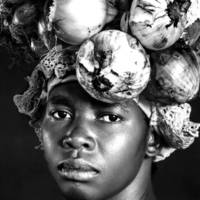
Women of the Congo: Photography of Isabel Muñoz and Concha Casajús, Museo Nacional de Antropologia, Madrid (17 March - 18 June 2017)
The Democratic Republic of the Congo has been plagued by conflicts over control, extraction and distribution of natural resources such as coltan, diamonds and oil. In this exhibition, photographers Isabel Muñoz, National Photography Award 2016, and Concha Casajús present the struggle of Congolese women in the face of the use of sexual violence as a weapon of war. The show is a series of portraits and testimonies of women from Bukavu, in the province of South Kivu, in the east of the country. The exhibition aims to make the situation of these women visible, as well as the violence they suffer. But at the same time, it invites us to reflect on the way in which these women face such suffering, rejecting in many cases the status of victims and trying to survive with dignity. Many have managed to get rid of this stigma and have struggled collectively to become activists and successful women. All a song to those women who have broken the silence and, from mutual support and sorority, have become true heroines of this twenty-first century.
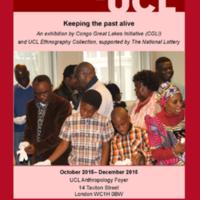
Keeping the Past Alive, UCL Anthropology Foyer (October 2015 - December 2015)
Keeping the Past Alive is a partnership between University College London's Ethnography Collection and Congo Great Lakes Initiative. The exhibition reflects the stories that Congolese community members share as and how they interact with objects, either personal, provocative or relational. It is divided into three topics: traditional power objects, sacred rituals and medicine, and everyday life. The objects on display tell stories, sometimes with a metaphor of their own, which will, we hope, make visitors internalize and discuss the messages they bring. This exhibition is the final step of our collaboration with Congo Great Lakes which started one year ago. During the project, an interactive platform which can host online exhibitions has been developed. The platform collects archives and documentation and shares the data with Horniman and UCL Congolese collections and members of CGLI.
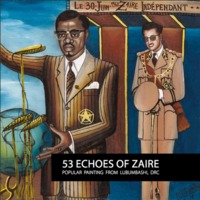
53 echoes of Zaire: Popular Painting from Lubumbashi Democratic Republic of Congo, Sulger-Buel Lovell Gallery, London (27 May – 30 June 2015)
Popular Painting is a genre traceable to the 1920s, which chronicles contemporary social and political realities in Congo (then Zaïre). This art movement remains very little known outside the continent. Scholars have dedicated their research activities to Popular Painting. They often knew the main actors of the movement in the early 1970s, and shared this knowledge by publishing articles, books and exhibition catalogues. “ During a brief period between the late sixties and the late seventies, popular genre painting bloomed in the urban and industrial Katanga region of the Democratic Republic of the Congo Artists, most of them self-educated, produced paintings (acrylics or oils on canvas reclaimed from flour sacking) for local use. Through a limited number of recurrent topics, they articulated a system of shared memories.
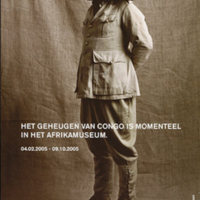
The Memory of the Congo in the Colonial Era, Royal Museum for Central Africa, Tevuren, Belgium ( 4 February 2005 - 9 October 2005)
With this exhibition, the RMCA aims to contribute to the highly topical debate concerning the colonial history of Congo and Belgium.
Visitors learn more about this controversial period through little-known objects, works of art, documents, films, and photographs. Filmed interviews with Belgians and Congolese give a voice to the past in a lively confrontation with memories and emotions. Memory of Congo, through specific themes and diverse narratives, revisits this turbulent chapter in history
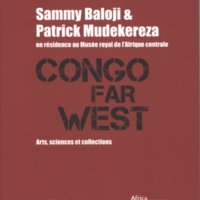
Artists in Residence. Sammy Baloji & Patrick Mudekereza,
Congo Far West, Royal Museum for Central Africa, Tevuren, Belgium (11 May – 4 September 2011)
In this exhibition the artists Sammy Baloji and Patrick Mudekereza present us with a contemporary take on the colonial past. As artists in residence in the museum they got carte blanche in the museum collections. In dialogue with scientists from the museum they have started working with a few collection pieces dating from the beginning of Congo’s colonial history. These collection pieces exhale the atmosphere of the conquest of Congolese territory by the West. The leitmotif of the exhibition ‘Congo Far West’ refers not only to this territorial conquest, but also to the contemporary Congolese artists who artistically and intellectually recapture the collection pieces conserved in the West.
Patrick Mudekereza is a writer and poet but he also writes texts for comic strips, exhibitions and audiovisual art. During his time in the museum he is working on a hybrid sculpture entitled L’art au Congo which raises a whole host of questions, and treaties signed with a cross which sealed the transfer of land from the local chefs to Leopold II. Photographer Sammy Baloji is working on a series of photographs and watercolours from a colonial exhibition led by Charles Lemaire. He has already exhibited in cities such as Paris, Bamako, Brussels, Cape Town and Bilbao. A Beautiful Time, his first solo exhibition in the United States, taking place in the Museum for African Art in New York, will be on show in in the Smithsonian National Museum of Natural History in Washington in 2012. Sammy Baloji and Patrick Mudekereza both live and work in Lubumbashi in DR Congo. Together they are organising the photography biennale Rencontres Picha in Lubumbashi, the third edition of which will take place in 2012.
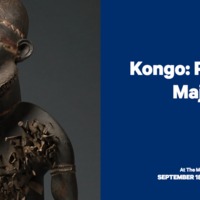
Kongo: Power and Majesty, Metropolitan Museum of Art, New York (18 September 2015 - January 3 2016)
Central Africa's Kongo civilization is responsible for one of the world's greatest artistic traditions. This international loan exhibition explores the region's history and culture through 146 of the most inspired creations of Kongo masters from the late fifteenth through the early twentieth century.
The earliest of these creations were diplomatic missives sent by Kongo sovereigns to their European counterparts during the Age of Exploration; they took the form of delicately carved ivories and finely woven raffia cloths embellished with abstract geometric patterns. Admired as marvels of human ingenuity, such Kongo works were preserved in princely European Kunstkammer, or cabinets of curiosities, alongside other precious and exotic creations from across the globe.
With works drawn from sixty institutional and private lenders across Europe and the United States, Kongo: Power and Majesty relates the objects on view to specific historical developments and challenges misconceptions of Africa's relationship with the West. In doing so, it offers a radical, new understanding of Kongo art over the last five hundred years.
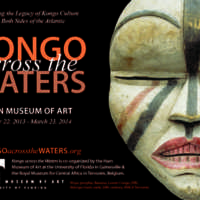
Kongo Across the Waters, Princeton Art Museum (25 October 2014 - 25 January 2015)
Kongo across the Waters examines 500 years of cultural exchange between the Kongo, Europe, and the United States, showing the rise of Kongo as a major Atlantic presence and the transmission of Kongo culture through the transatlantic slave trade into American art.
Drawing from the incomparable collections of the Royal Museum for Central Africa in Tervuren, Belgium, including masterpieces that have never before been seen in the United States, this groundbreaking exhibition investigates how the Kingdom of Kongo in West Central Africa evolved over five centuries and contributed to the cultural life of enslaved Africans and their descendants in North America. Manuscripts, maps, engravings, photographs, and videos provide contextual information, and the accompanying 448-page catalog further explores the art of the Kongo and of the Kongo diaspora.
Kongo across the Waters is a joint project organized by the Samuel P. Harn Museum of Art, University of Florida, Gainesville, Florida, and the Royal Museum for Central Africa, Tervuren, Belgium, and is supported by an indemnity from the Federal Council on the Arts and the Humanities. At Princeton, supplementary interpretive content has been developed by the Princeton University Art Museum. The exhibition at Princeton has been made possible by generous support from the National Endowment for the Arts; the Frances E. and Elias Wolf, Class of 1920, Fund; Susan and John Diekman, Class of 1965; the David A. Gardner ’69 Magic Project; the Department of Art and Archaeology, Princeton University; and an anonymous fund. Additional funds have been provided by the Allen R. Adler, Class of 1967, Exhibitions Fund; Heather and Paul G. Haaga Jr., Class of 1970; Holly and David Ross; Andrew W. Mellon Foundation; the New Jersey State Council on the Arts/Department of State, a Partner Agency of the National Endowment for the Arts; and by the Center for African American Studies, the Program in African Studies, the Office of Religious Life, the Lewis Center for the Arts, and the Department of English, Princeton University. Further support has been provided by the Partners and Friends of the Princeton University Art Museum.
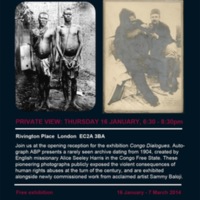
'When harmony goes to hell'. Congo Dialogues: Alice Seeley Harris and Sammy Baloji, Rivington Place, London (16 January - 7 March 2014)
Autograph ABP presents a rarely seen archive dating from 1904, created by English missionary Alice Seeley Harris in the Congo Free State. These pioneering photographs publicly exposed the violent consequences of human rights abuses at the turn of the century, and are exhibited alongside newly commissioned work from acclaimed contemporary Congolese artist Sammy Baloji.
In the early 1900s, the missionary Alice Seeley Harris produced what was probably the first photographic campaign in support of human rights. She exposed the atrocities that underpinned King Leopold II’s regime in the Congo Free State, bringing to public attention the plight of the Congolese people under a violent and oppressive regime.
These photographs fundamentally shifted public awareness of the deep-rooted hypocrisy of King Leopold II’s promise of colonial benevolence, and caused an outcry at the time of their publication in Europe and America.
Over 100 years later, these issues remain of primary concern to Congolese citizen and artist Sammy Baloji. Like Harris, Baloji uses photography as a medium to interrogate current political concerns with reference to the past. Acclaimed for his photomontage works that juxtapose desolate post-industrial landscapes with ethnographic archival imagery, Baloji explores the cultural and architectural ‘traces’ of a country forever haunted by the spectres of its colonial past; in particular, the southeastern Katanga province and its capital, the city of Lubumbashi.
In this new body of work-in-progress, commissioned by Autograph ABP, Baloji continues to investigate the colonial legacies and fractured histories that haunt contemporary Congolese society. Notions of African utopias, post-colonial disillusionment, and a quest for authenticity amidst ‘the ruins of modernity’ define Baloji’s multi-layered practice: the impact of Western imperialism, Maoist communism, urban segregation and colonial sanitation politics as well as the unending mineral exploitation of the Congo’s natural resources, and with it the tragedies and traumas of state-controlled violence and ongoing human rights abuses.
Congo Dialogues marks the 175th anniversary of Anti-Slavery International and the invention of photography. The first major solo showcase of Sammy Baloji’s work in the UK, this exhibition presents a unique opportunity to see both historical and contemporary works interrogating the Congo and its colonial legacies. The Alice Seeley Harris archive was last shown to the public 110 years ago.
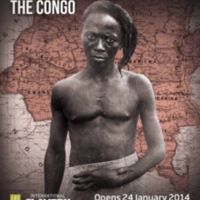
Brutal Exposure, International Slavery Museum, Liverpool (24 January 2015 - 7 June 2015)
This haunting exhibition documented the exploitation and brutality experienced by Congolese people under the control of Leopold II of Belgium in the 1900s. The photographs, by missionary Alice Seeley Harris, were at the time a radical and significant shift in the representation and understanding of the impact of colonial violence in the Congo, and exposed the deep-rooted hypocrisy of so called 'colonial benevolence' which cost the lives of millions of Congolese. The campaign led to public pressure and international scrutiny of Leopold’s administration, which came to an end in 1909.
The legacy of Belgian violence and exploitation would tragically re-emerge years later after the Congo gained independence in 1960, with the murder of the country’s first legally elected Prime Minister, Patrice Lumumba.
European exploitation of the Congolese people and resources has shaped the country's recent history and the effects are still evident today.
This exhibition was developed in partnership with Autograph ABP and Anti-Slavery International.